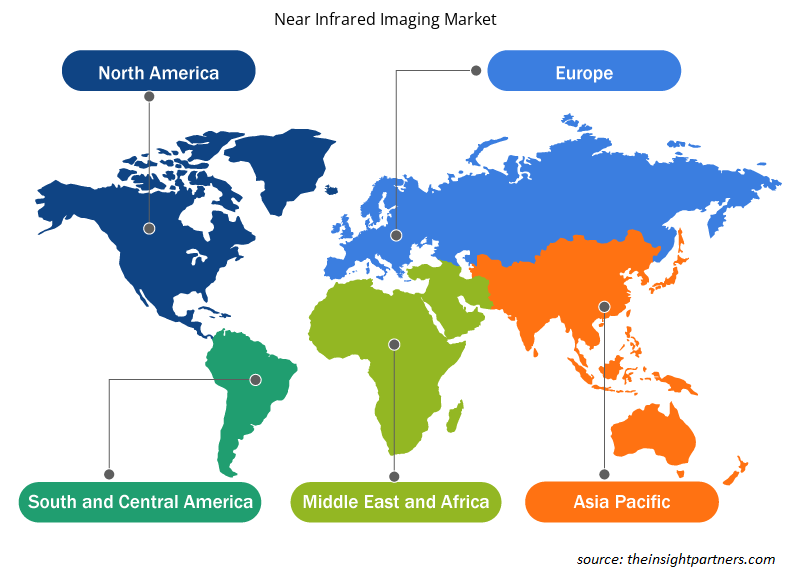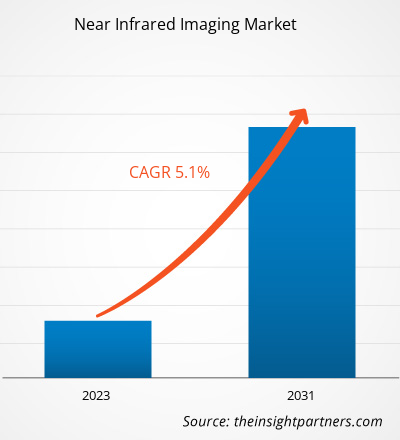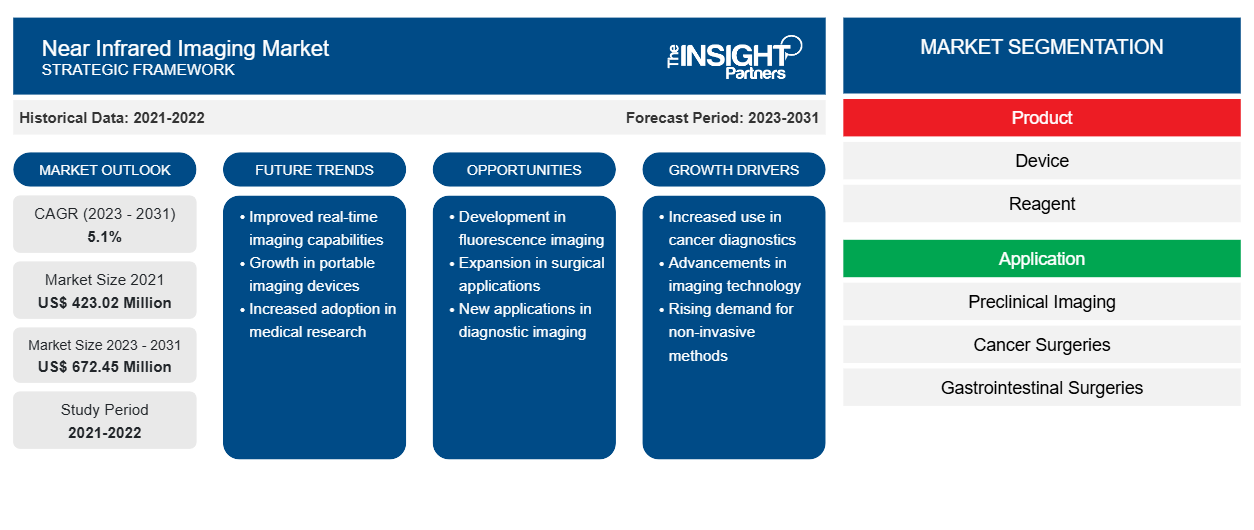Se estimó que el tamaño del mercado de imágenes de infrarrojo cercano sería de US$ 423,02 millones en 2021 y US$ XX millones en 2023 y se espera que alcance los US$ 672,45 millones para 2031; se estima que registrará una CAGR del 5,1% para 2031. Es probable que la consolidación siga siendo una tendencia clave en el mercado de imágenes de infrarrojo cercano.CAGR of 5.1% by 2031. Consolidation are likely to remain key near infrared imaging market trends.
Análisis del mercado de imágenes de infrarrojo cercano
La demanda de imágenes de infrarrojo cercano (NIR) está aumentando en todo el mundo, principalmente como reemplazo de la visión térmica o de infrarrojo lejano (FIR) utilizada para la visión nocturna. La imagen de infrarrojo cercano se considera un método poderoso para varias aplicaciones agronómicas. Además, la imagen de infrarrojo cercano es ventajosa con respecto a la visión térmica, ya que esta última solo ayuda a absorber el calor y no produce imágenes claras. Además, la imagen de cáncer con fluorescencia de infrarrojo cercano es una de las técnicas emergentes para aplicaciones clínicas y preclínicas para el tratamiento de pacientes con cáncer, ya que el NIR ofrece una alta resolución espacial, visualización en tiempo real, portabilidad y perfiles moleculares detallados mediante sondas fluorescentes multiplexadas.NIR) imaging is increasing across the world, majorly as a replacement for thermal or far-infrared (FIR) vision used for night vision. The near infrared imaging is considered a powerful approach for several agronomical applications. Additionally, the near infrared imaging is advantageous over thermal vision as the pre-clinical applications for the management of cancer patients as the NIR offers high spatial resolution, real-time display, portability, and detailed molecular profiling using multiplexed fluorescent probes.
Además, la luz en el rango infrarrojo cercano con una longitud de onda de 650 a 900 nm tiene varias ventajas sobre la luz del rango visible, que incluyen una penetración más profunda en los tejidos debido a una menor absorción por la hemoglobina y el agua, así como una menor autofluorescencia de los tejidos circundantes.
Las aplicaciones de imágenes por fluorescencia NIR son útiles en diversos procedimientos médicos, incluidas las imágenes neurológicas y del cáncer. Las aplicaciones NIR no solo actúan como una alternativa a los métodos de imágenes tradicionales, sino que también compensan diversas limitaciones de las técnicas de imágenes convencionales al emplear características únicas como la fluorescencia NIR. Por lo tanto, se espera que los beneficios que ofrece la imagenología de infrarrojo cercano también sean un factor destacado que impulse el crecimiento del mercado durante el período de pronóstico.
Descripción general del mercado de imágenes de infrarrojo cercano
Se espera que el crecimiento del mercado de imágenes de infrarrojo cercano sea responsable debido a factores como el aumento del número de procedimientos quirúrgicos y las ventajas que ofrece la imagenología de infrarrojo cercano. Sin embargo, se espera que la escasez de profesionales capacitados obstaculice el crecimiento del mercado hasta cierto punto. El mercado mundial de imágenes de infrarrojo cercano está segmentado por región en América del Norte, Europa, Asia-Pacífico, Medio Oriente y África, y América del Sur y Central. En América del Norte, Estados Unidos tiene una participación significativa del mercado de imágenes de infrarrojo cercano. Las innovaciones en los sistemas de imágenes NIR impulsan principalmente el crecimiento del mercado en el país. Los países de la región se centran en el desarrollo de productos basados en tecnología avanzada que ayuden a mejorar la calidad de vida de los pacientes.
Personalice este informe según sus necesidades
Obtendrá personalización en cualquier informe, sin cargo, incluidas partes de este informe o análisis a nivel de país, paquete de datos de Excel, así como también grandes ofertas y descuentos para empresas emergentes y universidades.
-
Obtenga las principales tendencias clave del mercado de este informe.Esta muestra GRATUITA incluirá análisis de datos, desde tendencias del mercado hasta estimaciones y pronósticos.
Factores impulsores y oportunidades del mercado de imágenes de infrarrojo cercano
Aumento del número de procedimientos quirúrgicos favorece al mercado
El informe anual de la Encuesta mundial sobre procedimientos estéticos/cosméticos de 2022, realizado por la Sociedad Internacional de Cirugía Plástica Estética (ISAPS), informó que hubo un aumento del 11,2% en el número total de procedimientos realizados por cirujanos plásticos en 2022. El informe también muestra que se realizaron más de 14,9 millones de procedimientos quirúrgicos a nivel mundial. Además, la encuesta indica un aumento constante de la cirugía estética con un aumento del 41,3% en los últimos cuatro años. El aumento de los procedimientos quirúrgicos ha incrementado el uso de equipos de visualización para realizar la cirugía. La microcirugía ha sido elegida por la población a gran escala debido al aumento de enfermedades crónicas causadas por la presión laboral, el estrés, los hábitos alimentarios inadecuados, la herencia y la exposición a sustancias químicas. Además, según la Sociedad Estadounidense de Cirujanos Plásticos, el aumento del número de diversas cirugías estéticas se ha convertido en uno de los principales factores de crecimiento del mercado. Por lo tanto, se espera que el aumento de los procedimientos quirúrgicos y el aumento de la concienciación impulsen el mercado de las imágenes de infrarrojo cercano en los próximos años.ISAPS) reported that there was an 11.2% increase in the total number of procedures performed by plastic surgeons in 2022. The report also shows that more than 14.9 million surgical procedures were performed globally. Additionally, the survey indicates a consistent increase in aesthetic surgery with a 41.3% rise over the last four years. A rise in surgical procedures has increased the use of visualization equipment to perform the surgery. Microsurgery has been opted by population on a large scale owing to increasing chronic diseases caused by work pressure, stress, improper eating habits, heredity, and exposure to chemicals. Additionally, according to American Society of Plastic Surgeons, an increase in number of several cosmetic surgeries has become one of the major factors for the market growth. Thus growing surgical procedures and rise in the awareness are expected to boost the near infrared imaging market in the coming years.
Énfasis en el turismo médico: una oportunidad en el mercado de imágenes de infrarrojo cercano
El turismo médico es uno de los principales factores que impulsan la adopción de imágenes médicas, incluida la NIR. El turismo médico está aumentando en América Latina y Asia Pacífico. Junto con estas regiones, la región del Medio Oriente también se está centrando en el turismo médico. Los países de estas regiones ofrecen servicios de la mejor calidad a bajo precio. Con el aumento de los costos de fabricación en relación con sus prácticas, los fabricantes de dispositivos médicos están luchando por generar suficientes ingresos para satisfacer a sus inversores. Se espera que los mercados emergentes en las economías en desarrollo sean el factor crucial que ofrezca mejores y lucrativas oportunidades de crecimiento para que los principales actores del mercado amplíen sus negocios y alcance geográfico.
Los pacientes viajan a otros países para recibir un tratamiento de calidad con el uso de productos, dispositivos y equipos de tecnología médica sofisticados y avanzados. Además, el turismo médico interno también está aumentando en los países en desarrollo.
Además, las autoridades gubernamentales de Asia Pacífico se están centrando en fortalecer su sector de turismo médico, maximizando así el flujo de ingresos. Polonia se ha convertido poco a poco en el mejor destino de turismo médico de Europa. Por ejemplo, en Polonia, los costes de los tratamientos médicos son un 60-80% inferiores a los del resto de los países de la UE. La principal razón del crecimiento del turismo es el reconocimiento y la aceptación de Polonia en la Unión Europea. Se prevé que el aumento del turismo médico en los países emergentes como Polonia proporcione importantes oportunidades de crecimiento a los actores que operan en el mercado durante el período previsto.
Análisis de segmentación del informe de mercado de imágenes de infrarrojo cercano
Los segmentos clave que contribuyeron a la derivación del análisis del mercado de imágenes de infrarrojo cercano son el producto y el usuario final.
Según el producto, el mercado de imágenes de infrarrojo cercano se divide en dispositivos y reactivos. El segmento de dispositivos tuvo una mayor participación de mercado en 2023. El segmento de dispositivos se divide además en sistemas de imágenes de fluorescencia de infrarrojo cercano y sistemas de imágenes de fluorescencia y bioluminiscencia de infrarrojo cercano. El segmento de reactivos se divide además en verde de indocianina (ICG) y otros reactivos.
- Por aplicación, el mercado está segmentado en imágenes preclínicas, cirugías oncológicas, cirugías gastrointestinales, cirugías cardiovasculares, cirugías plásticas/reconstructivas y otras aplicaciones. El segmento de cirugías oncológicas tuvo la mayor participación del mercado en 2023.
- En términos de usuario final, el mercado está segmentado en hospitales y clínicas, empresas farmacéuticas y biotecnológicas y laboratorios de investigación. El segmento de hospitales y clínicas dominó el mercado en 2023.
Análisis de la cuota de mercado de imágenes de infrarrojo cercano por geografía
El alcance geográfico del informe del mercado de imágenes de infrarrojo cercano se divide principalmente en cinco regiones: América del Norte, Asia Pacífico, Europa, Medio Oriente y África, y América del Sur / América del Sur y Central.
América del Norte es el mayor mercado de imágenes de infrarrojo cercano, y Estados Unidos tiene la mayor cuota de mercado, seguido de Canadá. Se espera que el mercado estadounidense de imágenes de infrarrojo cercano crezca debido al mercado farmacéutico y biotecnológico bien establecido. El crecimiento también se atribuye al aumento de la investigación y el desarrollo y al aumento de la investigación clínica y diagnóstica. Por lo tanto, las actividades de desarrollo de fármacos han aumentado drásticamente en todo el país. Por lo tanto, la demanda de imágenes de infrarrojo cercano está creciendo en el país.
Además, Estados Unidos también cuenta con sedes de algunos de los principales actores del mercado. Estos actores son constantes con el lanzamiento de productos nuevos y avanzados en el mercado. Por ejemplo, en mayo de 2021, Teledyne Technologies Incorporated adquirió FLIR Systems, Inc. FLIR opera bajo el nombre de Teledyne FLIR como parte del segmento de imágenes digitales de Teledyne. Se prevé que Asia Pacífico crezca con la CAGR más alta en los próximos años.
Perspectivas regionales del mercado de imágenes de infrarrojo cercano
Los analistas de Insight Partners explicaron en detalle las tendencias y los factores regionales que influyen en el mercado de imágenes de infrarrojo cercano durante el período de pronóstico. Esta sección también analiza los segmentos y la geografía del mercado de imágenes de infrarrojo cercano en América del Norte, Europa, Asia Pacífico, Oriente Medio y África, y América del Sur y Central.

- Obtenga datos regionales específicos para el mercado de imágenes de infrarrojo cercano
Alcance del informe de mercado de imágenes de infrarrojo cercano
| Atributo del informe | Detalles |
|---|---|
| Tamaño del mercado en 2021 | US$ 423,02 millones |
| Tamaño del mercado en 2031 | US$ 672,45 millones |
| CAGR global (2023 - 2031) | 5,1% |
| Datos históricos | 2021-2022 |
| Período de pronóstico | 2023-2031 |
| Segmentos cubiertos |
Por producto
|
| Regiones y países cubiertos |
América del norte
|
| Líderes del mercado y perfiles de empresas clave |
|
Densidad de actores del mercado: comprensión de su impacto en la dinámica empresarial
El mercado de imágenes de infrarrojo cercano está creciendo rápidamente, impulsado por la creciente demanda de los usuarios finales debido a factores como la evolución de las preferencias de los consumidores, los avances tecnológicos y una mayor conciencia de los beneficios del producto. A medida que aumenta la demanda, las empresas amplían sus ofertas, innovan para satisfacer las necesidades de los consumidores y aprovechan las tendencias emergentes, lo que impulsa aún más el crecimiento del mercado.
La densidad de actores del mercado se refiere a la distribución de las empresas o firmas que operan dentro de un mercado o industria en particular. Indica cuántos competidores (actores del mercado) están presentes en un espacio de mercado determinado en relación con su tamaño o valor total de mercado.
Las principales empresas que operan en el mercado de imágenes de infrarrojo cercano son:
- KARL STORZ SE & Co. KG
- Corporación Olympus
- Carl Zeiss Meditec AG
- Leica Microsystem Nussloch GmbH (Danaher)
- Fabricante: Perkin Elmer.
- Compañía: LI-COR, Inc.
Descargo de responsabilidad : Las empresas enumeradas anteriormente no están clasificadas en ningún orden particular.

- Obtenga una descripción general de los principales actores clave del mercado de imágenes de infrarrojo cercano
Noticias y desarrollos recientes del mercado de imágenes de infrarrojo cercano
El mercado de imágenes de infrarrojo cercano se evalúa mediante la recopilación de datos cualitativos y cuantitativos posteriores a la investigación primaria y secundaria, que incluye publicaciones corporativas importantes, datos de asociaciones y bases de datos. A continuación, se incluye una lista de los avances en el mercado de imágenes de infrarrojo cercano y las estrategias:
- En marzo de 2024, Artience Co., Ltd. lanzó la serie Sciforiem FI, una sonda de fluorescencia de infrarrojo cercano de alta sensibilidad que será fabricada y vendida por TOYOCOLOR CO., LTD. (Fuente: Artience Co., Ltd., comunicado de prensa, 2024)
- En julio de 2023, Nikon Corporation lanzó el microscopio confocal multifotónico de superresolución AX R MP con NSPARC, que permite una detección de matrices extremadamente sensible y una superresolución en áreas profundas dentro de especímenes de organismos vivos de gran tamaño. (Fuente: Nikon Corporation, 2023) [AT9]
- En agosto de 2022, Shimadzu, una empresa con sede en Japón, presentó el sistema de imágenes de infrarrojo cercano LuminousQuester NI. Este sistema consta de una cámara capaz de obtener imágenes de luz infrarroja cercana y luz visible simultáneamente y un software dedicado. Está diseñado para aplicaciones de investigación no clínica y respalda la investigación de descubrimiento de fármacos al combinar una cámara altamente flexible que se puede utilizar en una amplia gama de entornos con un software que tiene un alto grado de usabilidad. (Fuente: Shimadzu, comunicado de prensa, 2022)
- En junio de 2022, la franquicia Stryker Endoscopy Latam lanzó la campaña +FOCO. La campaña +FOCO brindó más conocimiento e información sobre la FLUORESCENCIA VERDE DE INDOCIANINA (ICG)*, una forma de visualizar el flujo sanguíneo y la perfusión tisular mediante el uso de un pigmento verde, que se activa con luz infrarroja cercana y se vuelve fluorescente (verde) cuando se utilizan módulos de imágenes avanzados como las cámaras STRYKER AIM. (Fuente: Stryker, comunicado de prensa, 2022)
Cobertura y resultados del informe de mercado de imágenes de infrarrojo cercano
El informe “Tamaño y pronóstico del mercado de imágenes de infrarrojo cercano (2021-2031)” proporciona un análisis detallado del mercado que cubre las siguientes áreas:
- Tamaño del mercado y pronóstico a nivel global, regional y nacional para todos los segmentos clave del mercado cubiertos bajo el alcance
- Dinámica del mercado, como impulsores, restricciones y oportunidades clave
- Principales tendencias futuras
- Análisis detallado de las cinco fuerzas de Porter y PEST y FODA
- Análisis del mercado global y regional que cubre las tendencias clave del mercado, los principales actores, las regulaciones y los desarrollos recientes del mercado.
- Análisis del panorama de la industria y de la competencia que abarca la concentración del mercado, el análisis de mapas de calor, los actores destacados y los desarrollos recientes
- Perfiles detallados de empresas
- Análisis histórico (2 años), año base, pronóstico (7 años) con CAGR
- Análisis PEST y FODA
- Tamaño del mercado, valor/volumen: global, regional y nacional
- Industria y panorama competitivo
- Conjunto de datos de Excel
Informes recientes
Testimonios
Razón para comprar
- Toma de decisiones informada
- Comprensión de la dinámica del mercado
- Análisis competitivo
- Información sobre clientes
- Pronósticos del mercado
- Mitigación de riesgos
- Planificación estratégica
- Justificación de la inversión
- Identificación de mercados emergentes
- Mejora de las estrategias de marketing
- Impulso de la eficiencia operativa
- Alineación con las tendencias regulatorias























 Obtenga una muestra gratuita para - Mercado de imágenes de infrarrojo cercano
Obtenga una muestra gratuita para - Mercado de imágenes de infrarrojo cercano